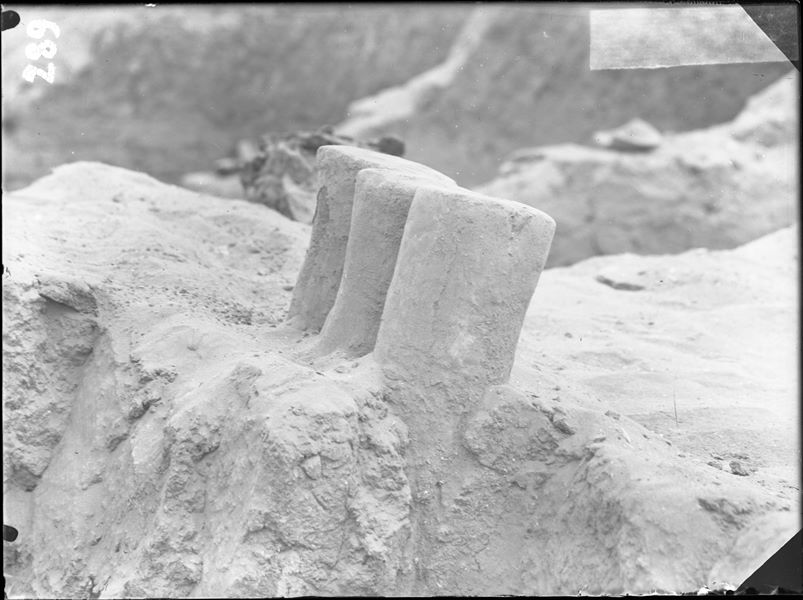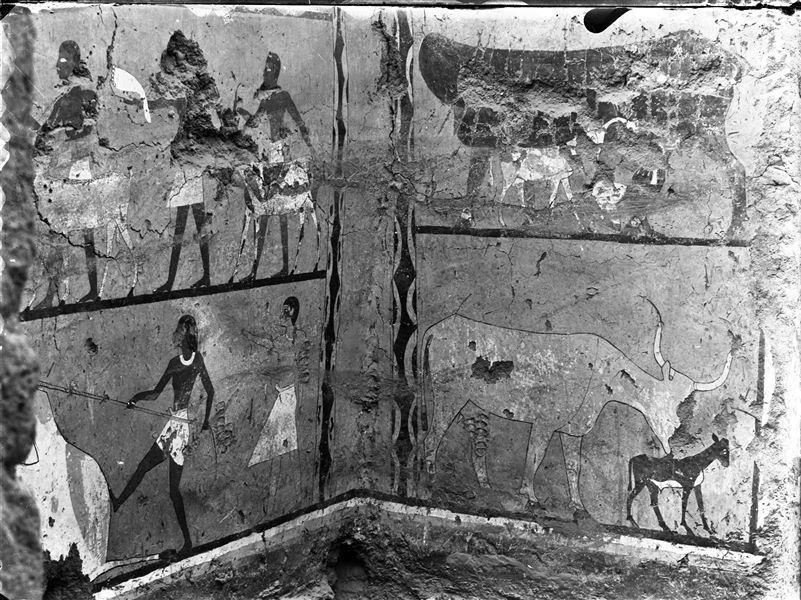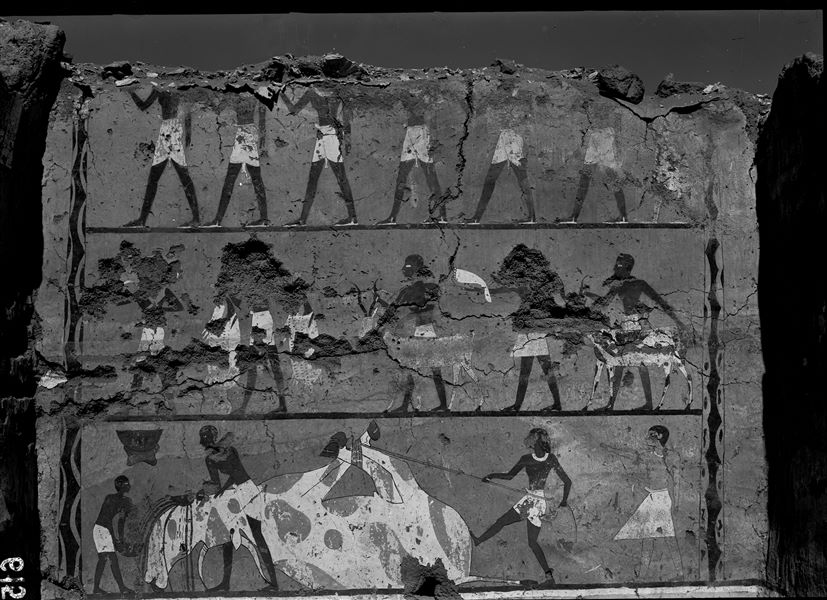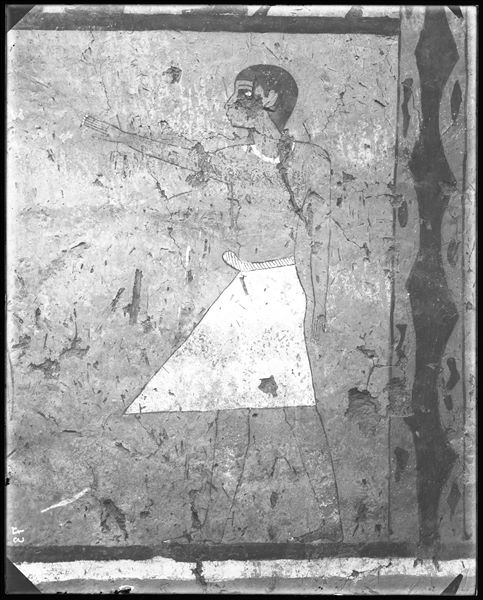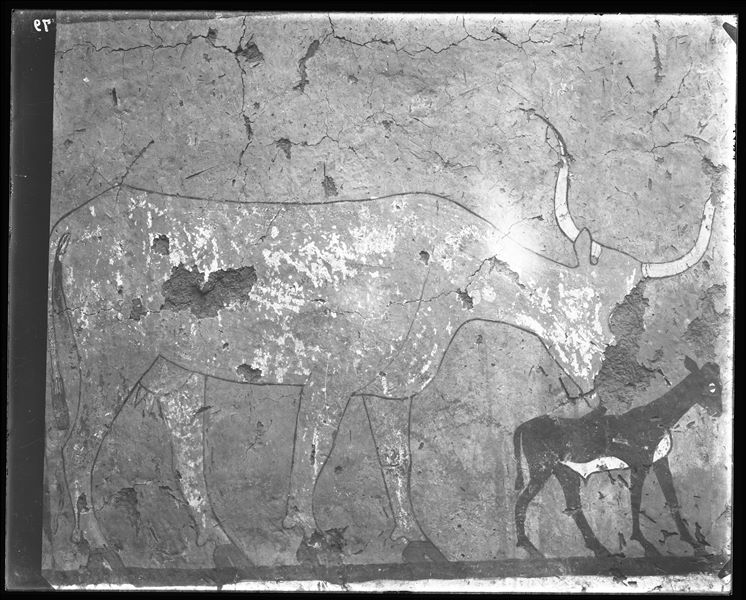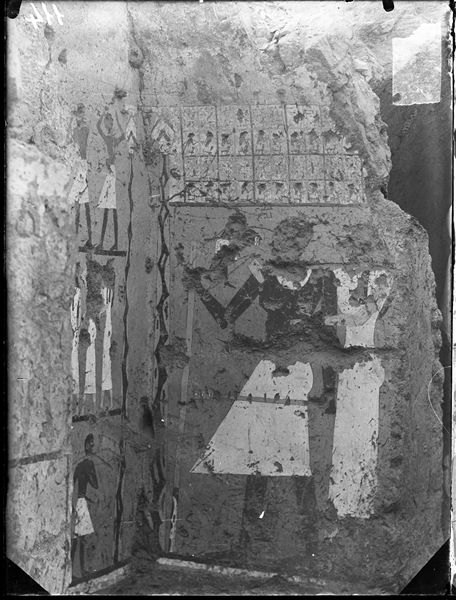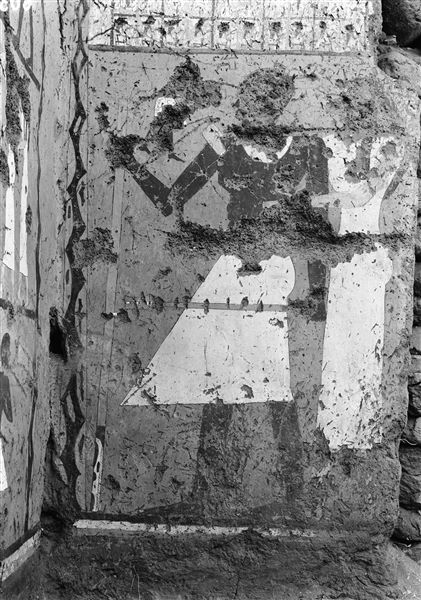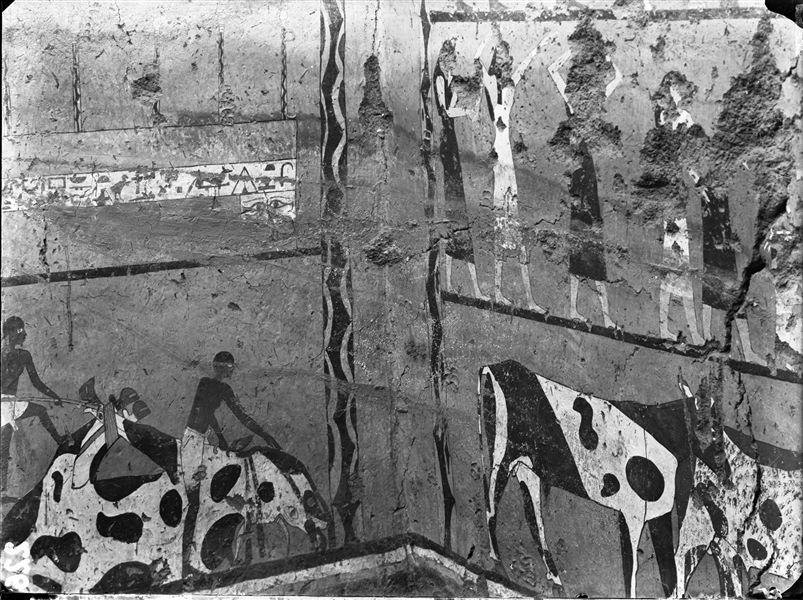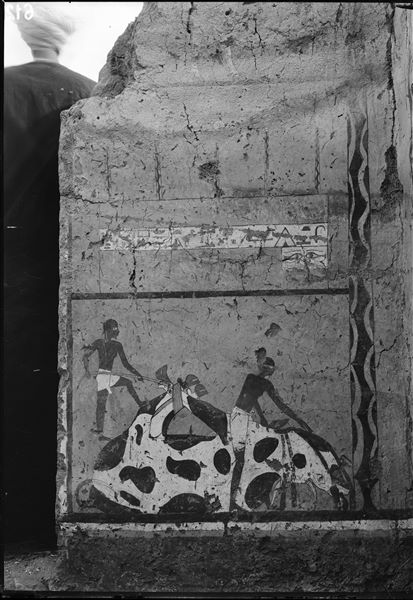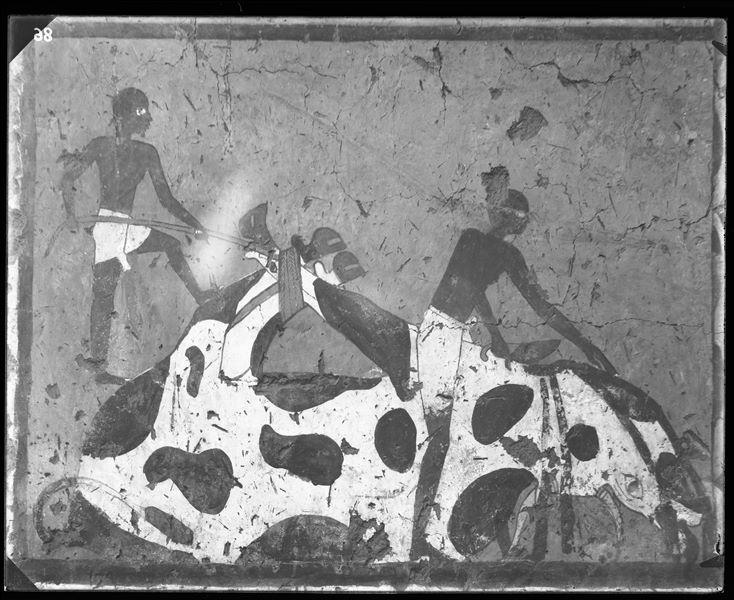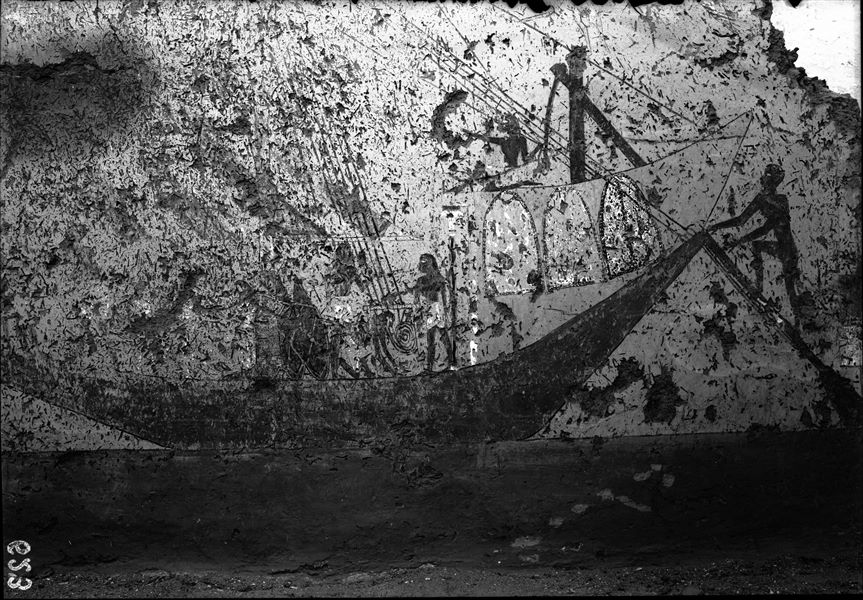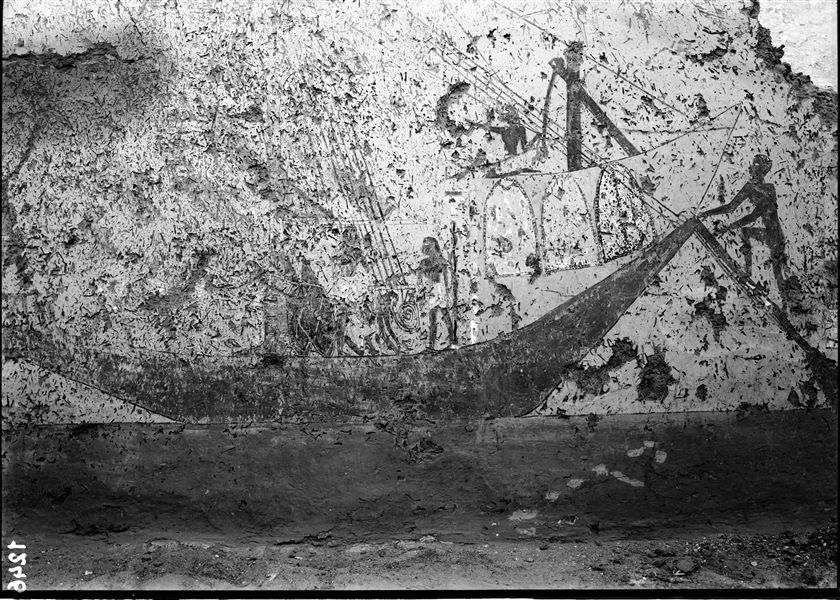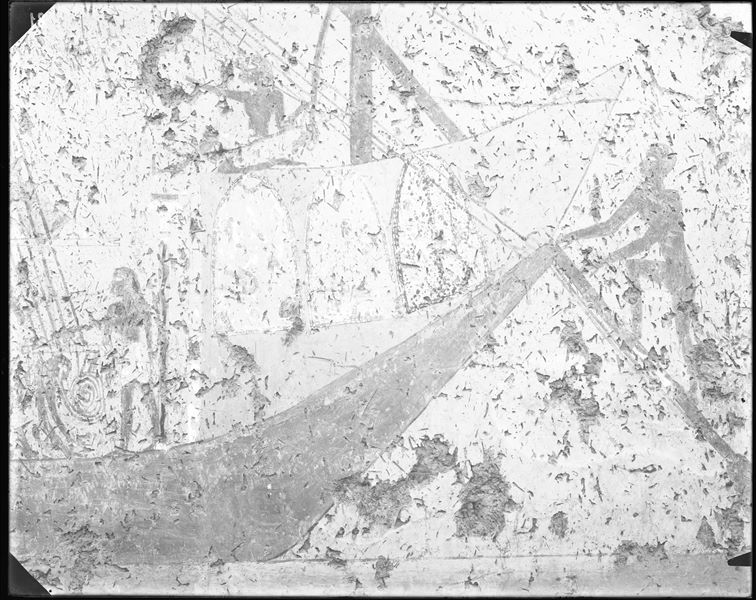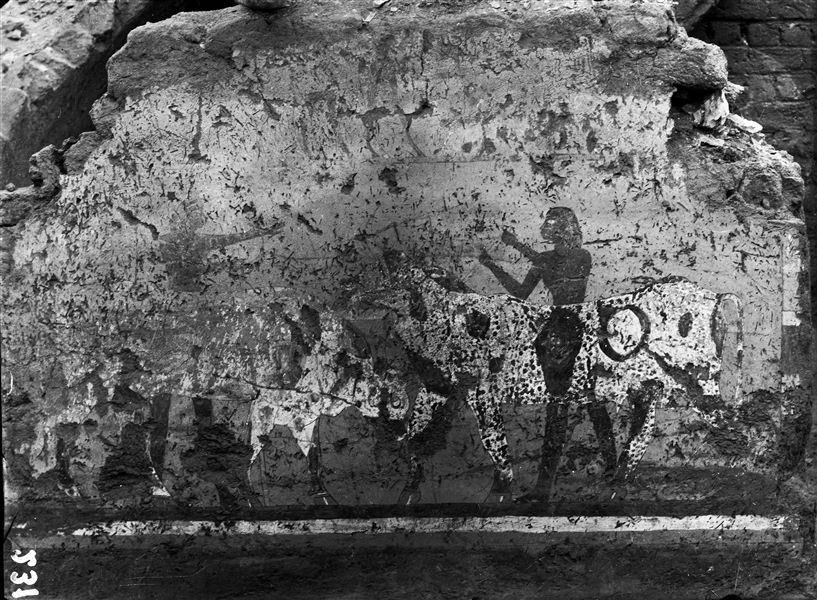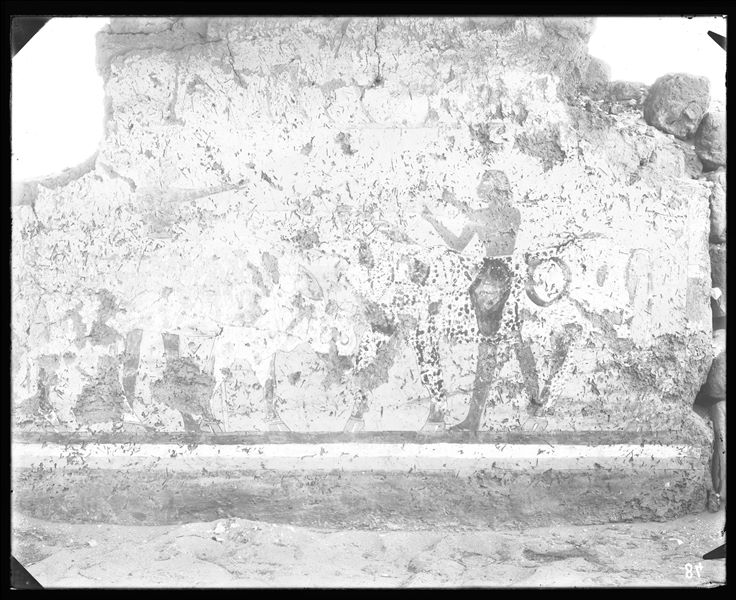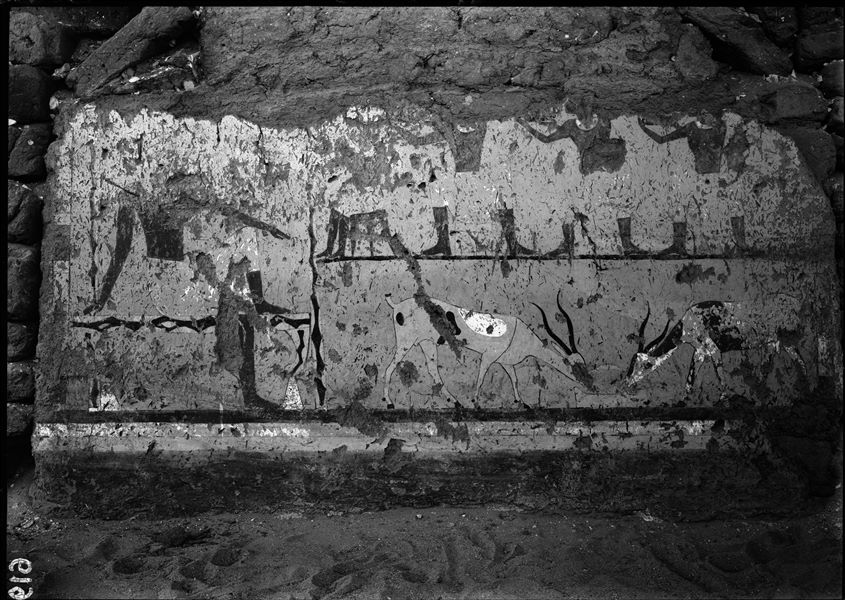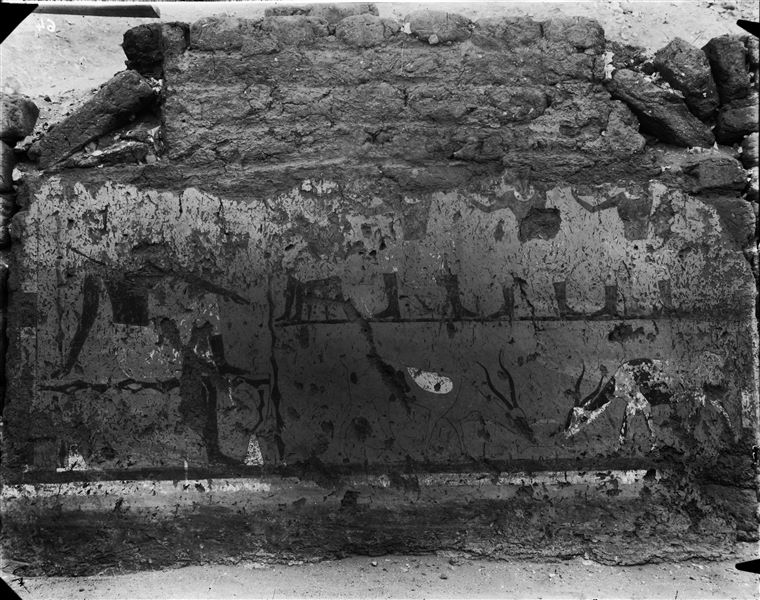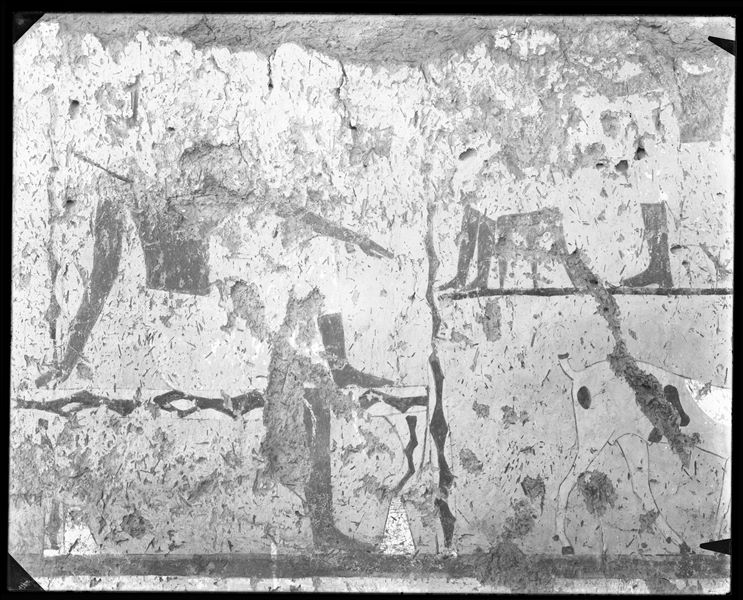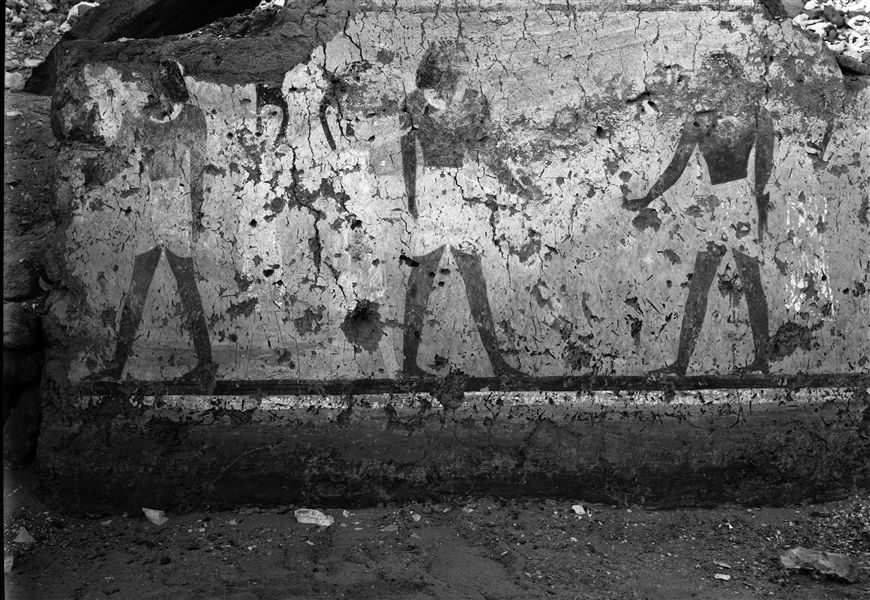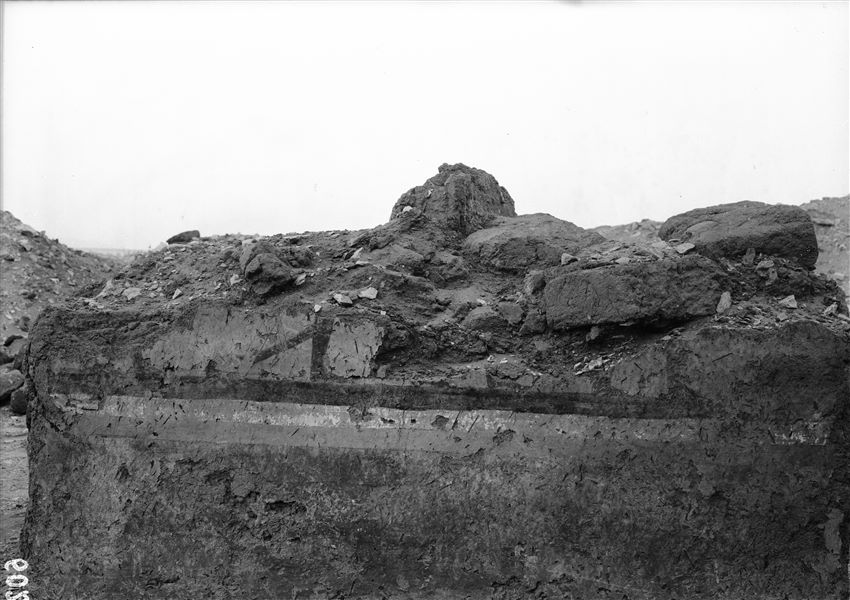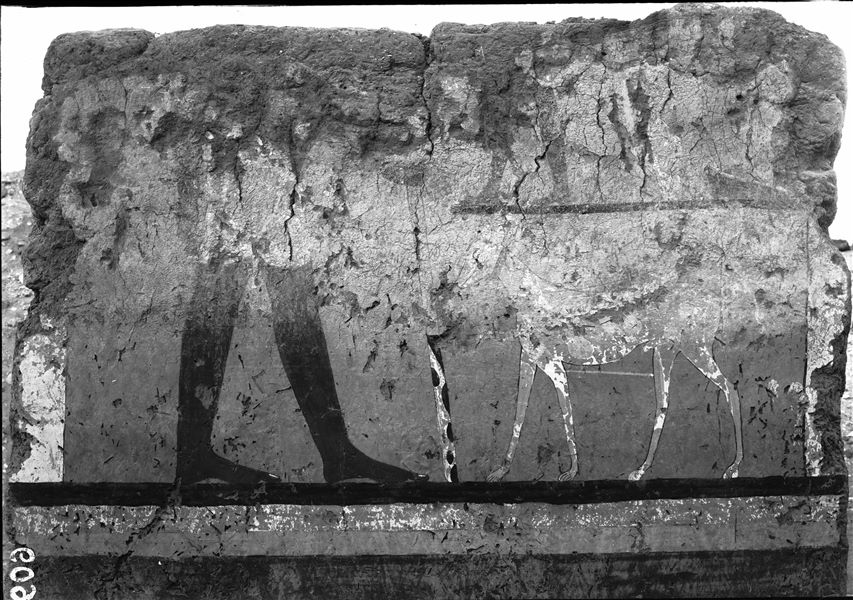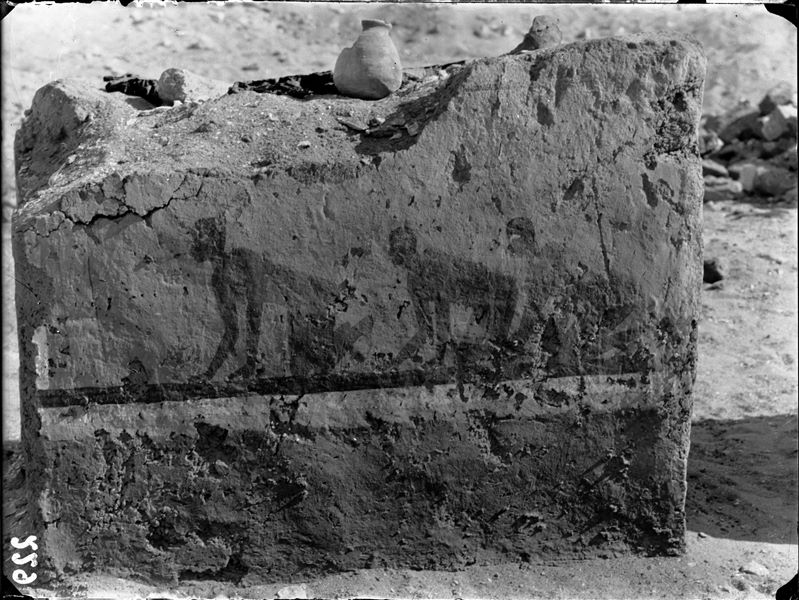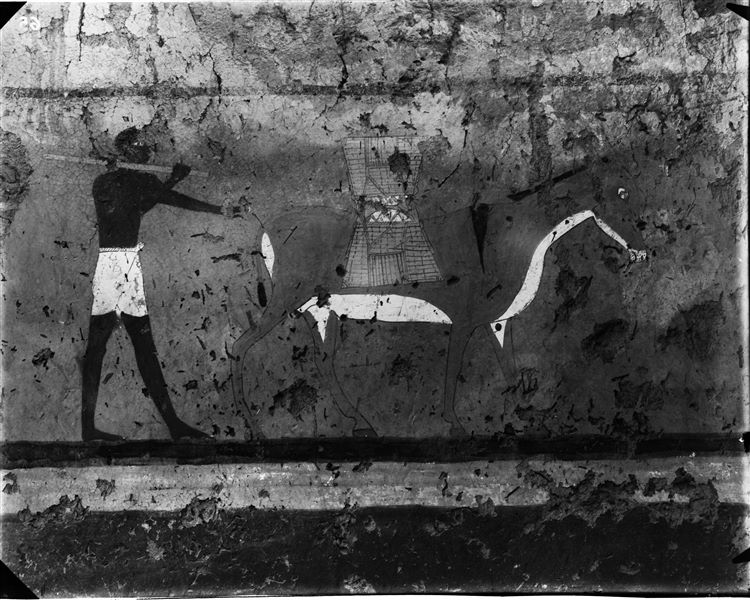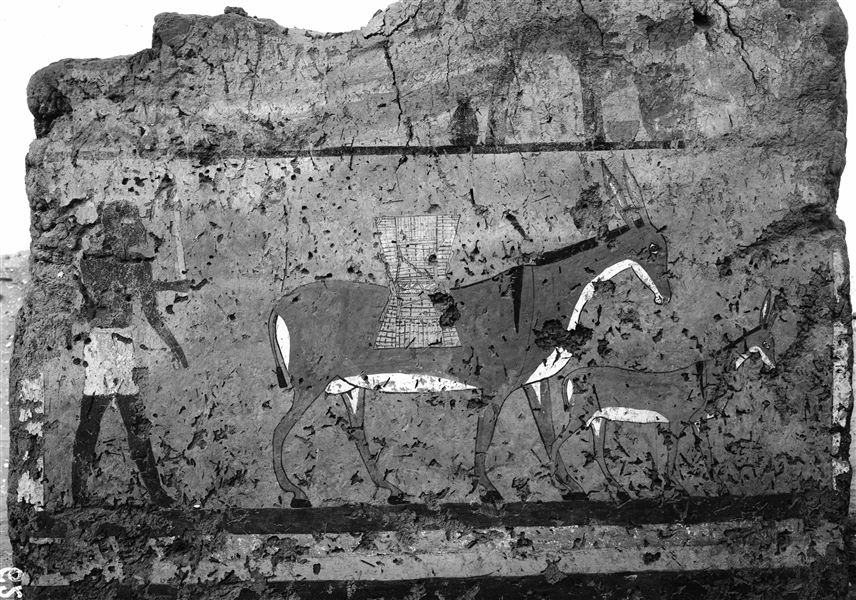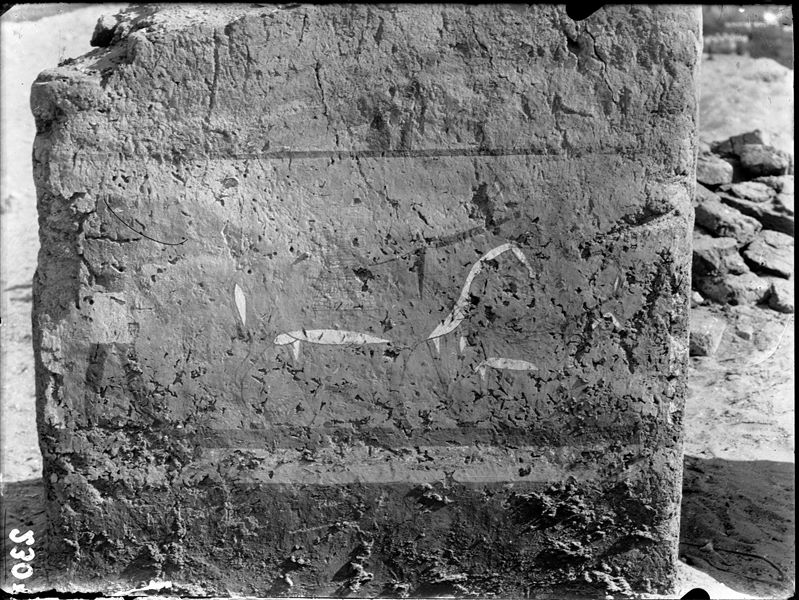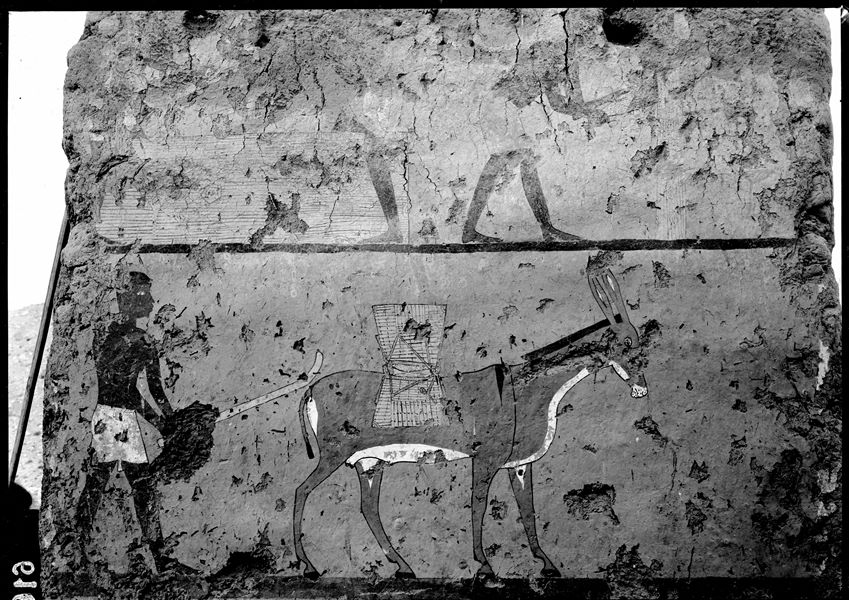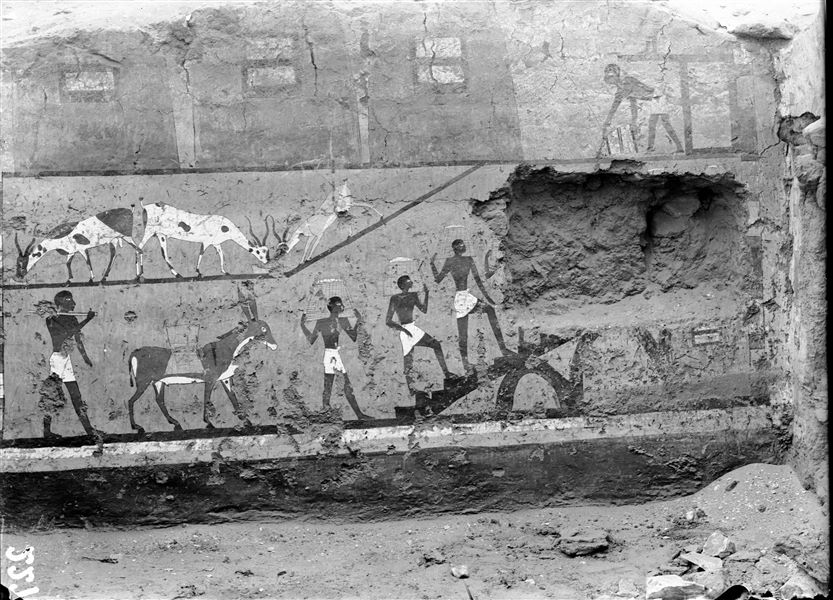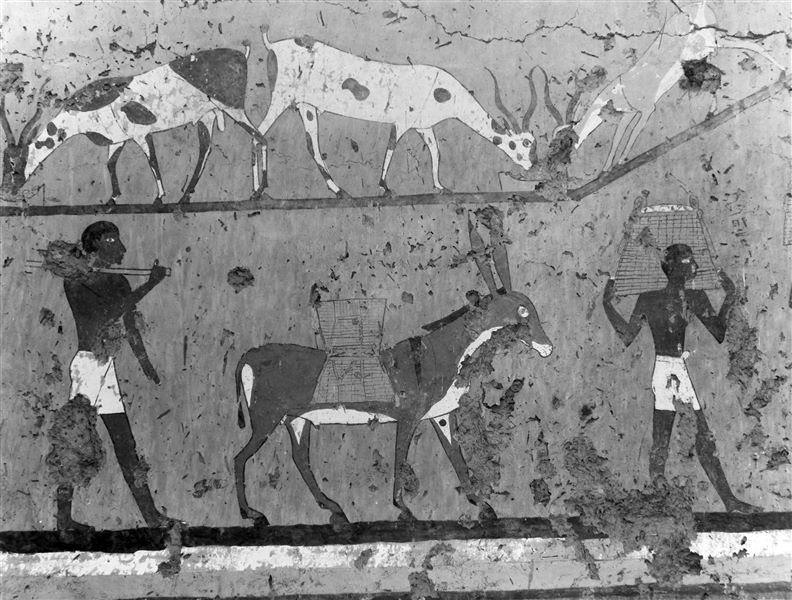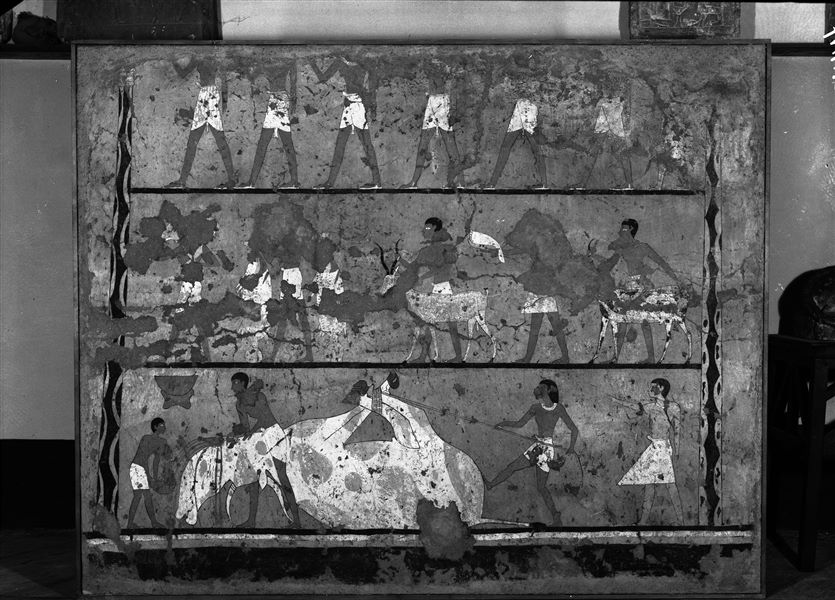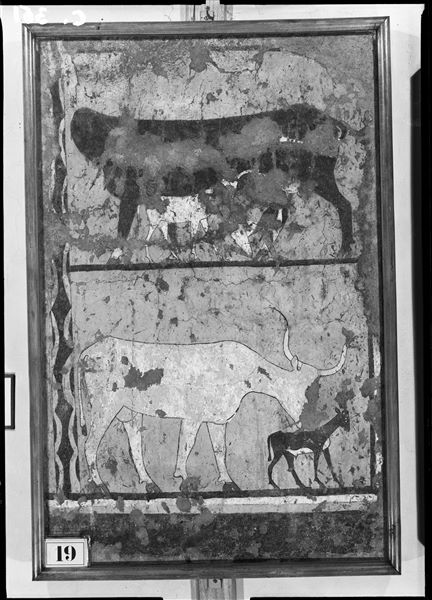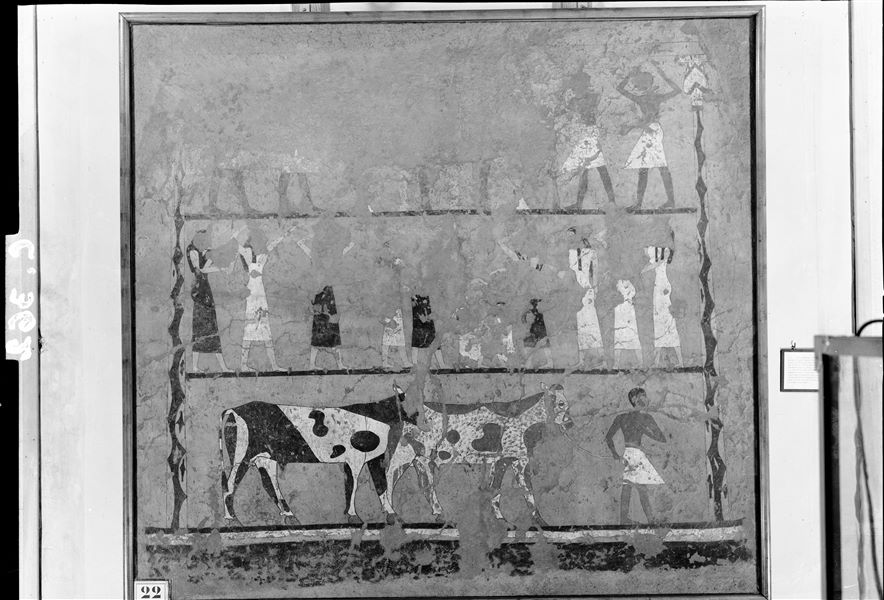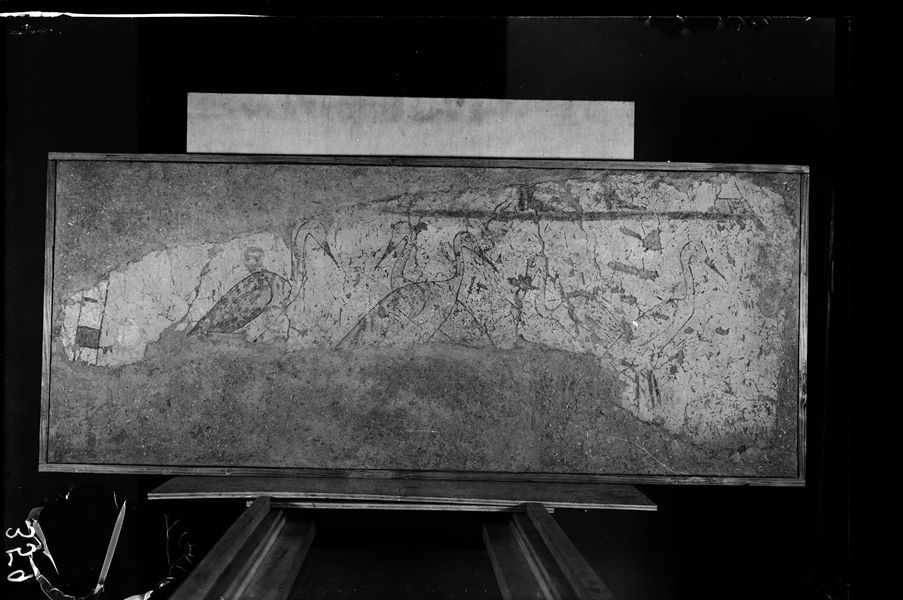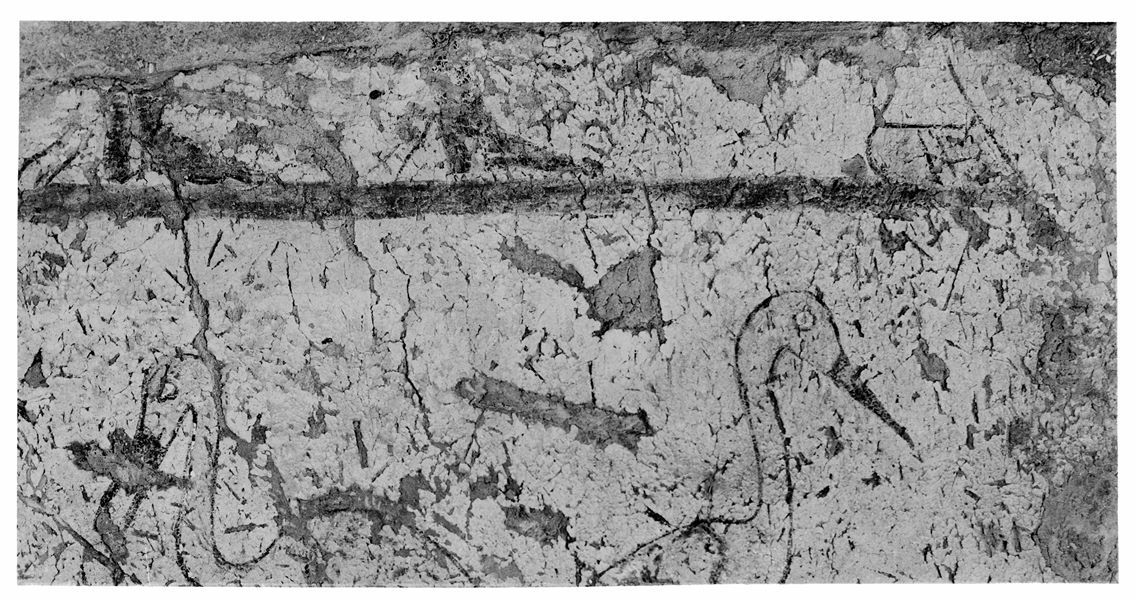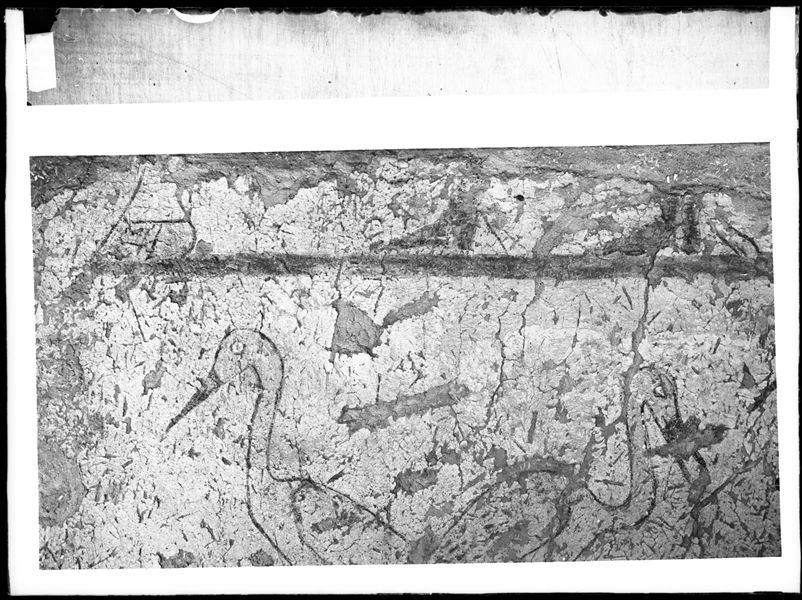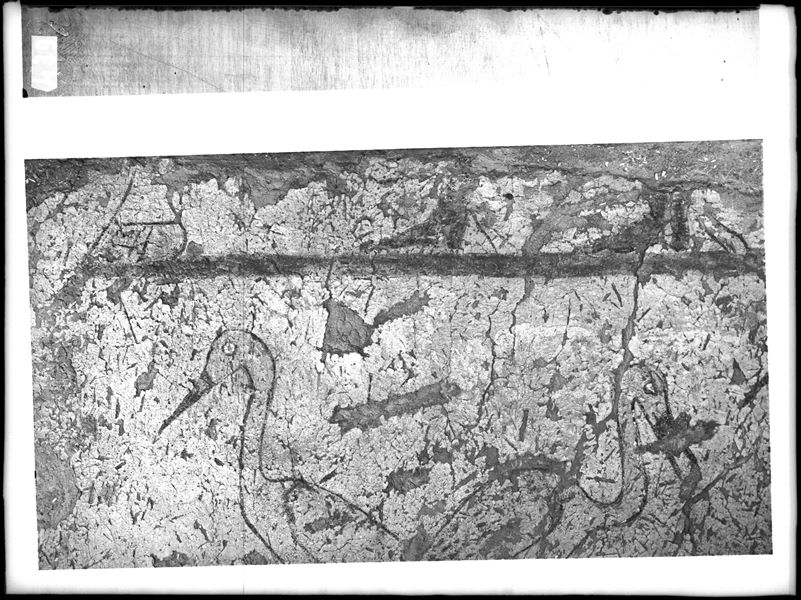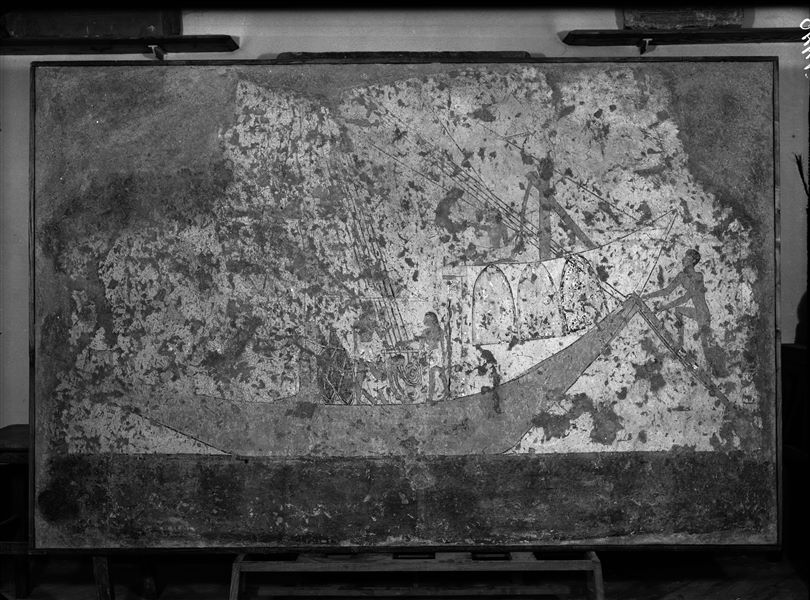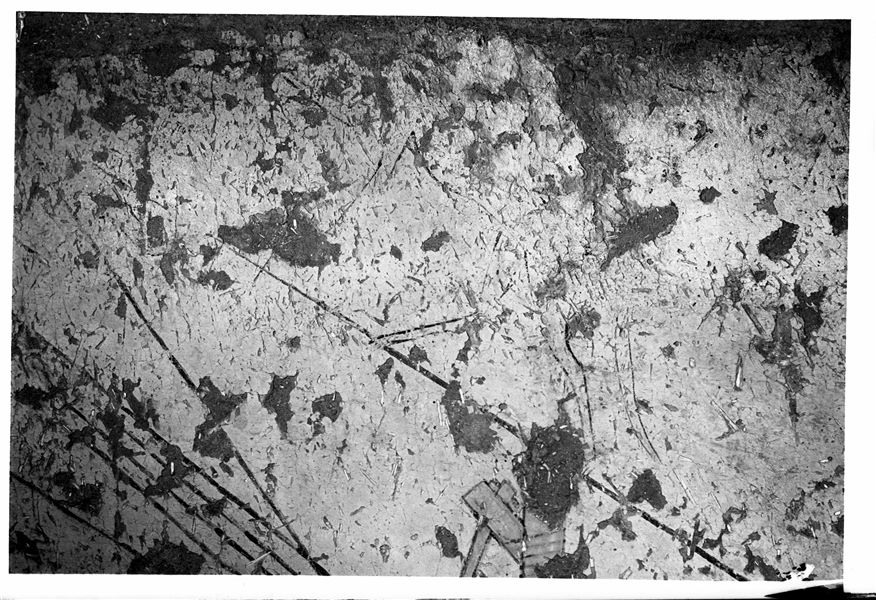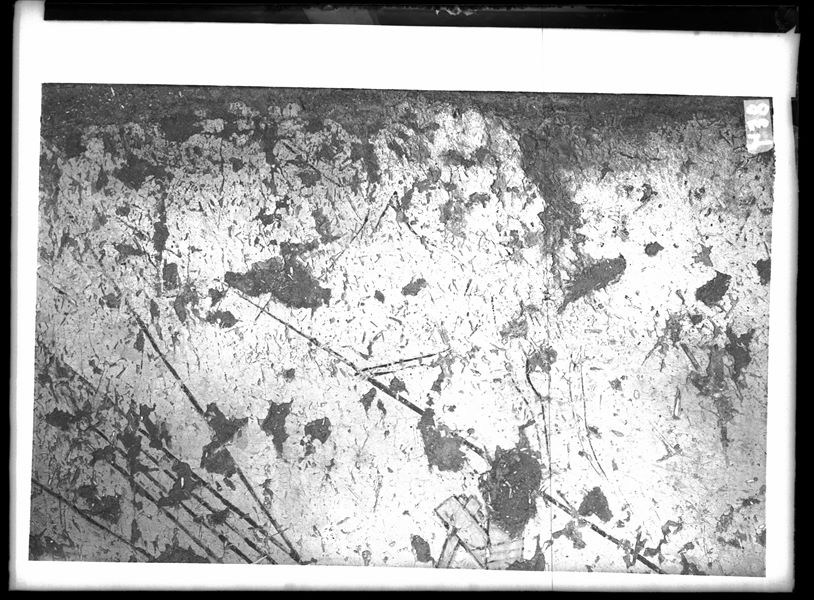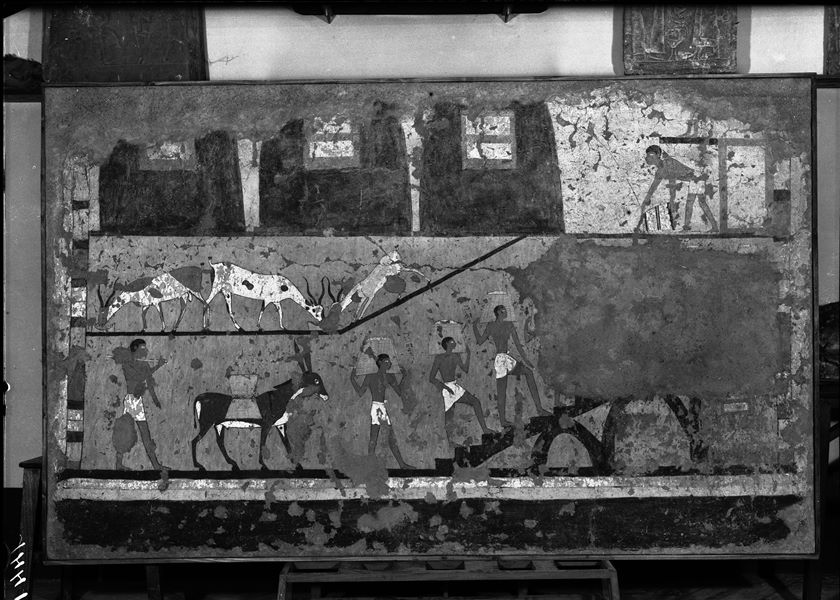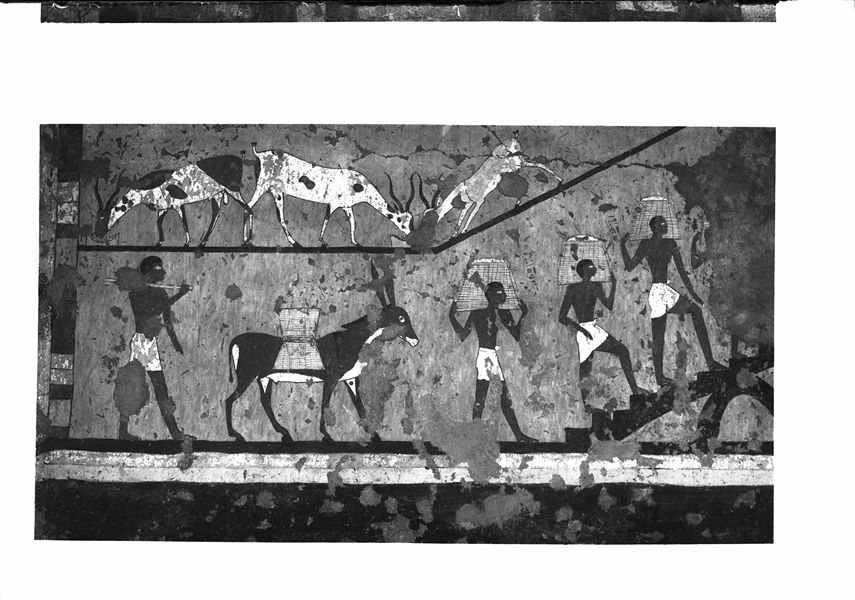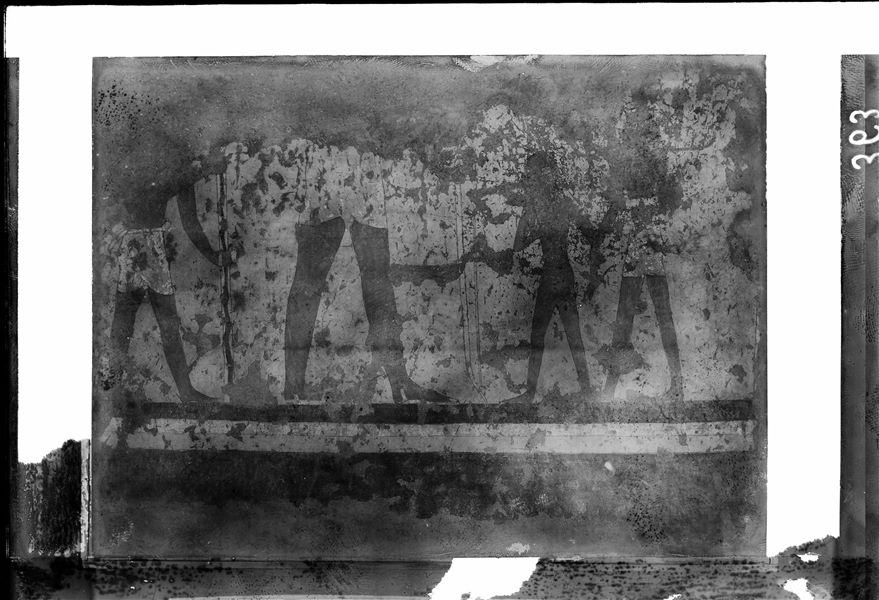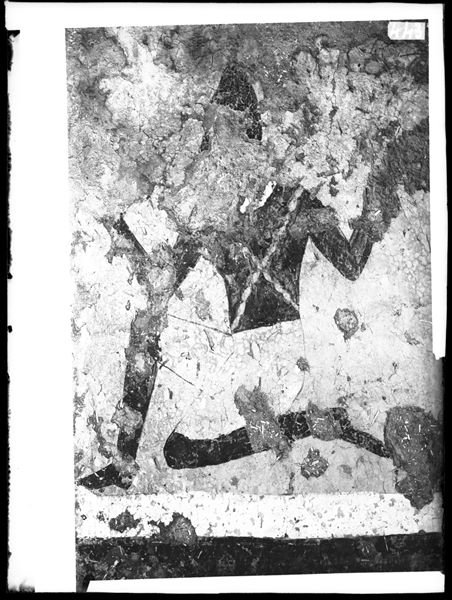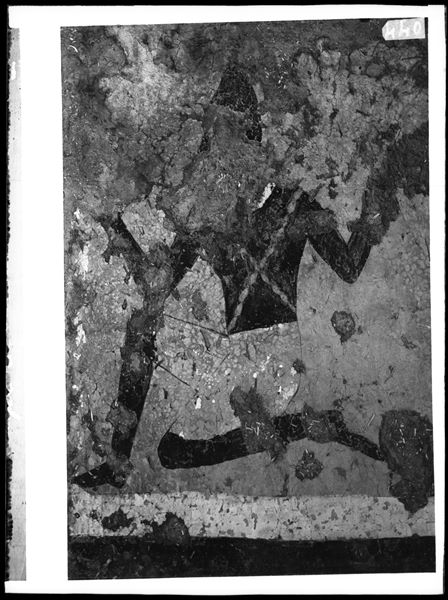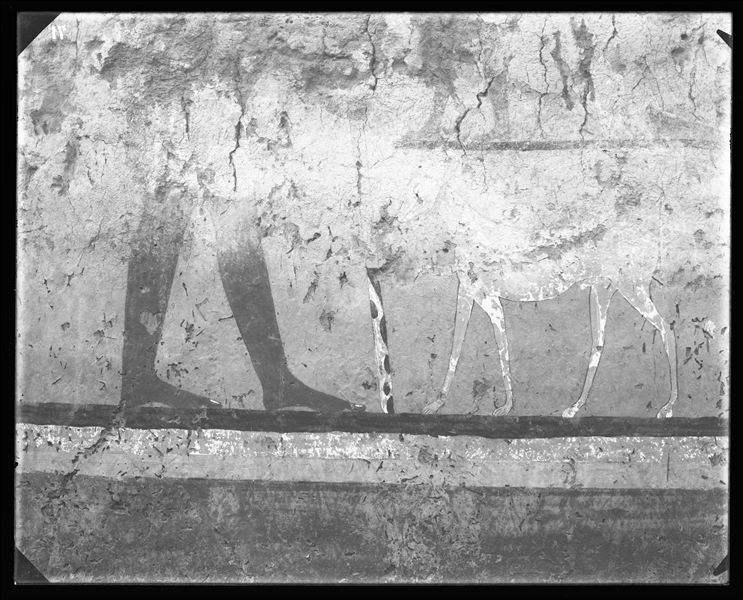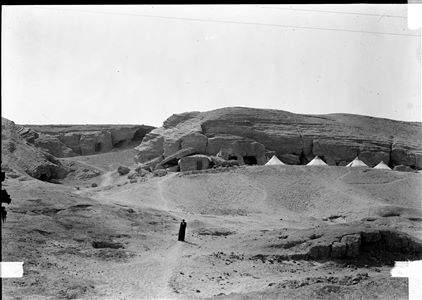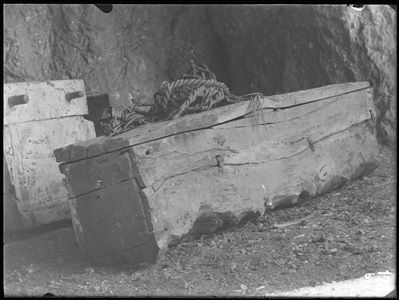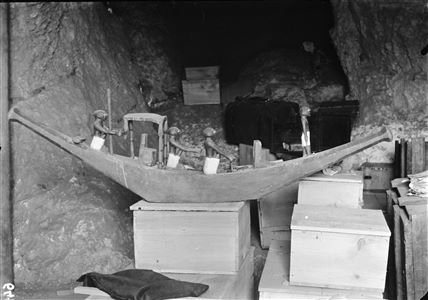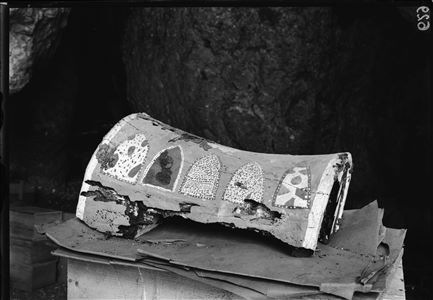Tomb of Iti "Chief of the troops" and "Treasurer of the King" and his wife Neferu. One of the rare images of the exterior of the tomb taken in early January 1911 by Virginio Rosa, a collaborator of Ernesto Schiaparelli, who was involved in the excavations at Gebelein that year. The photograph was taken immediately before excavating. The bases of the fourteen pillars which bordered the outer portico are already visible. Schiaparelli excavations.
Tomb of Iti and Neferu before excavations began. View of the central part of the half rock-cut structure. The vault of the central chapel is visible, as well as some of the precious paintings that decorated the walls of the outer portico. On the pillar in the centre is one of the many funerary cones found in the tomb. This tomb of undoubted beauty, can be dated to the First Intermediate Period (2118 - 1980 B.C.E). Schiaparelli excavations.
Tomb of Iti and Neferu. Three funerary cones still embedded in the wall where they were inserted. Schiaparelli excavations.
Tomb of Iti and Neferu. While excavating the tomb, precious tempera paintings were brought to light. In addition to their funerary context, they also document tasteful scenes related to daily life in an agricultural setting. The photograph shows the back wall, right side of the deceased’s cult chapel, depicting the couple in an affectionate pose dressed in white ceremonial clothes. Schiaparelli excavations.
Tomb of Iti and Neferu. The image shows the corner between the back wall and the right side-wall. The deceased couple is depicted on the left, and the right side-wall displays offering scenes of livestock and a ritual slaughter. Schiaparelli excavations.
Tomb of Iti and Neferu. The image shows the corner between the side-wall with the offering scenes (left) and the right wall with access to the room. The right wall shows a scene of a cow licking a newborn calf. Schiaparelli excavations.
Tomb of Iti and Neferu. Overall view of the right wall from the tomb owners’ cult chapel. The wall is dominated by a bloody scene showing the slaughter of a large ox held by ropes, with its blood being collected in bowls. The scene takes place under the direction of a man, depicted with an unusual pale complexion. In the upper registers, there are two processions with people bearing animal offerings. Schiaparelli excavations.
Tomb of Iti and Neferu. Detail of a ritual slaughter scene (not visible), under the direction of a man, depicted with an unusual pale complexion, perhaps Iti himself. The man is also depicted with stomach folds, a symbol of well-being. Schiaparelli excavations.
Tomb of Iti and Neferu. Displaying the right wall scene from the cult chapel's entrance wall. In addition to the scene of the cow with the calf, at the top there is a milking scene. Here, the calf competes with the herdsman for its mother's udder. Schiaparelli excavations.
Tomb of Iti and Neferu. Detail of the right wall scene from the cult chapel's entrance wall. The painting displays a cow licking its newborn calf. Schiaparelli excavations.
Tomb of Iti and Neferu. The image shows the back wall, left side, from the deceased’s cult chapel. Depicting the couple in an affectionate pose wearing white ceremonial clothes. Iti holds the traditional symbols of authority: a long staff and the kherep sceptre. Schiaparelli excavations.
Tomb of Iti and Neferu. The image shows a detail from the back wall, left side, from the cult chapel of the deceased. Showing the couple wearing white ceremonial clothes. Iti holds the traditional symbols of authority: a long staff and the kherep sceptre. Schiaparelli excavations.
Tomb of Iti and Neferu. The image shows the corner between the left side-wall and the entrance wall into the room (left side of the photograph). On the left side-wall at the top, women are depicted with their hands raised in what appears to be a funeral send-off. On the latter wall, the top shows the coffin of the deceased and at the bottom, a scene of ritual slaughter. Schiaparelli excavations.
Tomb of Iti and Neferu. View of the left side-wall from the deceased’s cult chapel. At the top, women are depicted with their hands raised in what appears to be a funeral send-off. At the bottom, a herdsman leads two cows towards the interior of the chapel, to demonstrate the availability of food for the deceased. Schiaparelli excavations.
Tomb of Iti and Neferu. View of the left side-wall from the deceased’s cult chapel. At the top, women are depicted with their hands raised in what appears to be a funeral send-off. At the bottom, a herdsman leads two cows towards the interior of the chapel, to demonstrate the availability of food for the deceased. Schiaparelli excavations.
Tomb of Iti and Neferu. Left wall scene from the cult chapel’s entrance wall. At the top, the large quadrangular coffin of the tomb owner in light wood, placed under an elegant canopy. Below is a ritual slaughter scene. Schiaparelli excavations.
Tomb of Iti and Neferu. Left wall scene from the cult chapel’s entrance wall. In the bottom register, a ritual slaughter scene. Schiaparelli excavations.
Tomb of Iti and Neferu. Detail from the left wall scene, entrance wall to the cult chapel depicting the tomb owner’s coffin. In the white band, there is an offering formula for the deceased written in hieroglyphs. A pair of painted eyes allows the deceased to see outside from within the coffin. Schiaparelli excavations.
Tomb of Iti and Neferu. The facade of the tomb, protected by the long portico, had 11 openings that led into as many rooms; the stretches of wall between each opening were decorated. This photograph documents the first fragmentary painting (starting from the south), depicting some cranes. Schiaparelli excavations.
Tomb of Iti and Neferu. The painting, rich in detail, shows a large boat about to set sail. This depiction could be linked to one of Iti’s activities, as being the "Chief of troops" also required long journeys. Schiaparelli excavations.
Tomb of Iti and Neferu. The painting, rich in detail, shows a large boat about to set sail. This depiction could be linked to one of Iti’s activities, as being the "Chief of troops" also required long journeys. Schiaparelli excavations.
Tomb of Iti and Neferu. Detail of the stern of Iti's large boat, about to set sail. In the foreground, there are shields hanging from the cabin, while one of the crewmen hurries to board the ship. Schiaparelli excavations.
Tomb of Iti and Neferu. This painting, partly ruined, depicts two bulls butting heads while two herdsmen try to separate them. In the upper register there is an incomplete scene with various animals, including giraffes; a species that inhabited the southern regions of Nubia. Schiaparelli excavations.
Tomb of Iti and Neferu. This painting, partly ruined, depicts two bulls butting heads while two herdsmen try to separate them. In the upper register there is an incomplete scene with various animals, including giraffes; a species that inhabited the southern regions of Nubia. Schiaparelli excavations.
Tomb of Iti and Neferu. This scene depicts the deceased Iti seated on a stool lined with cowhide in the shade of a pavilion, watching two tame antelopes feeding. Above are four male figures, one is shown seated, while the others are shown standing and drawn from a frontal view. Schiaparelli excavations.
Tomb of Iti and Neferu. This scene depicts the deceased Iti seated on a stool lined with cowhide in the shade of a pavilion, watching two tame antelopes feeding. Above are four male figures, one is shown seated, while the others are shown standing and drawn from a frontal view. Schiaparelli excavations.
Tomb of Iti and Neferu. Detail from a more extensive painting showing the deceased Iti seated on a stool in a resting pose. Depicted around him are animals and various people at work. Schiaparelli excavations.
Tomb of Iti and Neferu. This painting depicts two women mixing ingredients for making beer, which will then be stored in sealed terracotta jars. Schiaparelli excavations.
Tomb of Iti and Neferu. This photograph, showing only the left side of the painting, depicts one of two male figures followed by a pair of greyhounds, probably in the presence of Iti.
Tomb of Iti and Neferu. The painting depicts three male figures with short kilts, each accompanied by women wearing long white dresses. The central figure, with slightly larger proportions could possibly be Iti. For unknown reasons this painting did not reach Turin, perhaps it was damaged during its detachment. In addition to this image, there are notes from Virginio Rosa, placing the painting on the stretch of wall between the eighth and ninth rooms. Schiaparelli excavations.
Tomb of Iti and Neferu. This painting, not present in the museum, is known to us only through this image and a brief description made by Virginio Rosa at the time of its discovery. You can see the legs of "a damaged figure of a cow (white and pink) and a calf (red) that drinks milk). Schiaparelli excavations.
Tomb of Iti and Neferu. Pillar number 2. In the centre of the scene, the larger figure represents Iti, holding a bow. In front of him, a soldier presents a naked boy, perhaps a captive of war. Behind Iti, a man holds a pole covered with cowhide that probably held a banner. Schiaparelli excavations.
Tomb of Iti and Neferu. Pillar number 3. Four soldiers are shown wearing their characteristic clothing with crossed bands on their chests and carrying large shields made of wood and leather. Schiaparelli excavations.
Tomb of Iti and Neferu. Pillar number 5. This painting, a section remaining from the original wall scene, displays what could be a scene of working in the fields. Some men with a reddish complexion are walking towards the right, behind the second male figure on the left, there is a wooden tool, perhaps a hoe or a plough. Schiaparelli excavations.
Tomb of Iti and Neferu. Pillar number 6. This very fragmentary wall painting displays a mating scene between hippos where the female is clearly visible. The second figure, which was still visible at the time of its discovery, was described by Virginio Rosa in his excavation journal. Schiaparelli excavations.
Tomb of Iti and Neferu. Pillar number 7. In this painting the deceased is depicted standing and holding his long staff, together with one of his dogs. He is wearing elegant sandals with wooden soles and laces between his toes, made of vegetable fibre or leather. Schiaparelli excavations.
Tomb of Iti and Neferu. Pillar number 8. This painting presents an unusual scene depicting a standing figure leaning forward, holding a dark-skinned person by the hair, probably a prisoner from the southern regions of Egypt. Schiaparelli excavations.
Tomb of Iti and Neferu. Pillar number 9. The deceased is shown standing and holding a staff with its lower end covered in spotted cow skin. In front of him is an elegant greyhound with a red collar, one of five examples of such depicted in the tomb. Schiaparelli excavations.
Tomb of Iti and Neferu. Pillar number 10. This painting depicts Iti holding a long staff wearing a large white linen kilt. One of his hounds sniffs the ground at his feet. Schiaparelli excavations.
Tomb of Iti and Neferu. Pillar number 11. Three young male figures are depicted kneeling, their nudity suggests that they are war captives. Schiaparelli excavations.
Tomb of Iti and Neferu. Pillar number 11. Three young male figures are depicted kneeling, their nudity suggests that they are war captives. Schiaparelli excavations.
Tomb of Iti and Neferu. Pillar number 11. Three young male figures are depicted kneeling, their nudity suggests they are war captives. Schiaparelli excavations.
Tomb of Iti and Neferu. Pillar number 12. A man is depicted leading a donkey carrying two baskets tied together on its back; the basket on the left side of the animal (usually not seen) is drawn above the other in order to make it visible. Schiaparelli excavations.
Tomb of Iti and Neferu. Pillar number 12. A man is depicted leading a donkey carrying two baskets tied together on its back; the basket on the left side of the animal (usually not seen) is drawn above the other in order to make it visible. Schiaparelli excavations.
Tomb of Iti and Neferu. Pillar number 13. A scene showing one of the donkeys in the troop on its way to the granary. The donkey, preceded by its young, carries two baskets tied together; the one on its left side (usually not seen) is drawn above the other in order to make it visible. Schiaparelli excavations.
Tomb of Iti and Neferu. Pillar number 13. This poor quality image displays the same scene as in (C00620). A donkey, together with its young, heads towards the granary with its load of grain, followed by the farmer. Schiaparelli excavations.
Tomb of Iti and Neferu. Pillar number 14 (last pillar). In the upper part of the painting, two workers can be seen making a coffin, perhaps the one for the deceased himself. A carpenter on the left is holding an axe, while another saws a wooden board. In the lower register, a donkey carrying two baskets has been beaten by a herdsman on its rear, as the wounds inflicted by the stick are visible. Schiaparelli excavations.
Tomb of Iti and Neferu. End wall of the south-facing facade. This scene is divided into two panels. At the top, an antelope is shown held on a leash by a man. At the bottom, one of the many donkeys loaded with grain is about to reach the granary; depicted on the back wall of the portico. Schiaparelli excavations.
Tomb of Iti and Neferu. This picture documents almost in its entirety, the large painting that was present on the main wall of the portico in front of the tomb. The scene is dominated by the presence of some silos for storing grain and is the final destination for the procession of donkeys represented on the pillars. Here the grain is carried by hand to the top of the granary, to be poured out and measured, all documented and checked by a scribe. Part of the painting is missing due to the placement of a funerary stele "of the archers" (S.13115) on the wall, linked to reusing the tomb in later times. Schiaparelli excavations.
Tomb of Iti and Neferu. The image shows a donkey being freed from its load after reaching the granary. An attendant will carry the grain on his shoulders towards the granary. Above, three tame antelopes eat from their bowl filled with wheat grains. Schiaparelli excavations.
Tomb of Iti and Neferu. Museum display. During the 1911 excavation campaign. While excavating the tomb, precious tempera paintings were brought to light. In addition to their funerary context, they also document tasteful scenes related to daily life in an agricultural setting. The paintings were then detached and brought to the Museum during the campaign of 1913-14, as documented by these pictures. The photograph shows the back wall, right side, of the deceased’s cult chapel, depicting the couple in an affectionate pose wearing white ceremonial clothes. Schiaparelli excavations.(S.14354/10)
Tomb of Iti and Neferu. Museum display. Overall view of the right wall from the tomb owners’ cult chapel. The wall is dominated by a bloody scene showing the slaughter of a large ox held by ropes, with its blood being collected in bowls. The scene takes place under the direction of a man, depicted with an unusual pale complexion. In the upper registers, there are two processions with people bearing animal offerings. Schiaparelli excavations. (S.14354/12)
Tomb of Iti and Neferu. Museum display. The image shows the right part of the cult chapel’s entrance wall. In addition to the scene displaying a cow licking her newborn calf, above, there is a milking scene where the calf competes with the herdsman for its mother's udder. Schiaparelli excavations. (S.14354/13)
Tomb of Iti and Neferu. Museum display. In the two upper registers men and women are depicted with raised hands, probably in the act of mourning. At the bottom, a herdsman leads two different types of cattle. Schiaparelli excavations. (S.14354/9)
Tomb of Iti and Neferu. Museum display. Left wall scene from the cult chapel’s entrance wall. At the top, the large quadrangular coffin of the tomb owner in light wood, placed under an elegant canopy. Below is a ritual slaughter scene. Schiaparelli excavations. (S.14354/8)
Tomb of Iti and Neferu. Museum display. The facade of the tomb, protected by the long portico, had 11 openings that led into as many rooms; the stretches of wall between each opening were decorated. This photograph documents the first fragmentary painting (starting from the south), depicting some cranes. Schiaparelli excavations. (S.14354/19)
Tomb of Iti and Neferu. Detail of the heads of two cranes, depicted in the previous image. Schiaparelli excavations. (S.14354/19)
Tomb of Iti and Neferu. Detail of two cranes depicted in image C00359. The photograph is rotated horizontally 180°. Schiaparelli excavations. (S.14354/19)
Tomb of Iti and Neferu. Detail of two cranes depicted in image C00359. The photograph is rotated horizontally 180°. Schiaparelli excavations. (S.14354/19)
Tomb of Iti and Neferu. Museum display. The painting, rich in detail, shows a large boat about to set sail. This depiction could be linked to one of Iti’s activities, as being the "Chief of troops" also required long journeys. Schiaparelli excavations. (S.14354/07)
Tomb of Iti and Neferu. The image displays a detail from the previous photo, where a monkey can be seen climbing the rigging to board the boat. Schiaparelli excavations. (S.14354/07)
Tomb of Iti and Neferu. The image displays a detail from photograph C01446, where a monkey can be seen climbing the rigging to board the boat. Schiaparelli excavations. (S.14354/07)
Tomb of Iti and Neferu. The image shows a detail of photograph C01446, where a monkey can be seen climbing the rigging to board the boat. The photograph is rotated horizontally 180°. Schiaparelli excavations. (S.14354/07)
Tomb of Iti and Neferu. Museum display. This painting, partly ruined, depicts two bulls butting heads while two herdsmen try to separate them. In the upper register there is an incomplete scene with various animals, including giraffes; a species that inhabited the southern regions of Nubia. Schiaparelli excavations (S.14354/24).
Tomb of Iti and Neferu. Museum display. This scene depicts the deceased Iti seated on a stool lined with cowhide in the shade of a pavilion, watching two tame antelopes feeding. Above are four male figures, one is shown seated, while the others are shown standing and drawn from a frontal view. Schiaparelli excavations (S.14354/14).
Tomb of Iti and Neferu. Museum display. This picture documents almost in its entirety, the large painting that was present on the main wall of the portico in front of the tomb. The scene is dominated by the presence of some silos for storing grain and is the final destination for the procession of donkeys represented on the pillars. Here the grain is carried by hand to the top of the granary, to be poured out and measured, all documented and checked by a scribe. Part of the painting is missing due to the placement of a funerary stele "of the archers" (S.13115) on the wall, linked to reusing the tomb in later times. Schiaparelli excavations. (S.14354/15)
Tomb of Iti and Neferu. Museum display. This picture documents almost in its entirety, the large painting that was present on the main wall of the portico in front of the tomb. The scene is dominated by the presence of some silos for storing grain and is the final destination for the procession of donkeys represented on the pillars. Here the grain is carried by hand to the top of the granary, to be poured out and measured, all documented and checked by a scribe. Part of the painting is missing due to the placement of a funerary stele "of the archers" (S.13115) on the wall, linked to reusing the tomb in later times. Schiaparelli excavations. (S.14354/15)
Tomb of Iti and Neferu. The image shows a detail from the previous picture. As soon as the donkeys reach the granary they are freed from their load and the grain is carried by hand to the top of the silo. In the upper register, three tame antelopes eat from bowls filled with grain. Schiaparelli excavations. (S.14354/15).
Tomb of Iti and Neferu. Museum display. Pillar number 2. In the centre of the scene, the larger figure represents Iti, holding a bow. In front of him, a soldier presents a naked boy, perhaps a captive of war. Behind Iti, a man holds a pole covered with cowhide that probably held a banner. Schiaparelli excavations. (S.14354/04)
Tomb of Iti and Neferu. Pillar number 8. This image shows a detail from photograph E.00066, displaying an unusual representation of a dark-skinned person, probably a prisoner from the regions south of Egypt. Schiaparelli excavations. (S.14354/02)
Tomb of Iti and Neferu. Pillar number 8. The image, rotated 180° shows a detail from photograph E.00066. It displays an unusual representation of a dark-skinned person, probably a prisoner from the regions south of Egypt. Schiaparelli excavations. (S.14354/02)
Tomb of Iti and Neferu. Pillar number 8. The image, rotated 180° shows a detail from photograph E.00066. It displays an unusual representation of a dark-skinned person, probably a prisoner from the regions south of Egypt. Schiaparelli excavations. (S.14354/02)
Tomb of Iti and Neferu. Pillar number 8. The image, rotated 180° shows a detail from photograph E.00066. It displays an unusual representation of a dark-skinned person, probably a prisoner from the regions south of Egypt. Schiaparelli excavations. (S.14354/02)
Tomb of Iti and Neferu. Pillar number 8. The image, rotated 180° shows a detail from photograph E.00066. It displays an unusual representation of a dark-skinned person, probably a prisoner from the regions south of Egypt. Schiaparelli excavations. (S.14354/02)
Tomb of Iti and Neferu. Pillar number 9. The deceased is shown standing and holding a staff with its lower end covered in spotted cow skin. In front of him is an elegant greyhound with a red collar, one of five examples of such depicted in the tomb. Schiaparelli excavations. (S.14354/03)
Tomb of Iti and Neferu. Pillar number 10. This painting depicts Iti holding a long staff wearing a large white linen kilt. One of his hounds sniffs the ground at his feet. Schiaparelli excavations. (S.14354/01)
Tomb of Iti and Neferu. Museum display. Pillar number 11. Three young male figures are depicted kneeling, their nudity suggests that they are war captives. Schiaparelli excavations. (S.14354/06)
Tomb of Iti and Neferu. Pillar number 13. A scene showing one of the donkeys in the troop on its way to the granary. The donkey, preceded by its young, carries two baskets tied together; the one on its left side (usually not seen) is drawn above the other in order to make it visible. Schiaparelli excavations. (S.14354/20)
Tomb of Iti and Neferu. End wall of the south-facing facade. This scene is divided into two panels. At the top, an antelope is shown held on a leash by a man. At the bottom, one of the many donkeys loaded with grain is about to reach the granary; depicted on the back wall of the portico. Schiaparelli excavations. (S.14354/22)
A detached and consolidated painting from the tomb of Iti and Neferu, ready to be transported to Turin together with the other paintings. Schiaparelli excavations.

Paintings removed from the decorated tomb of Iti and Neferu at Gebelein in 1914. The image shows the installation of the paintings in the cloister of the Church of Sant' Apollonia in Florence, during an exhibition organised in 1924 by Fabrizio Lucarini, who had supervised their restoration.

Paintings removed from the decorated tomb of Iti and Neferu at Gebelein in 1914. The image shows the installation of the paintings in the cloister of the Church of Sant' Apollonia in Florence, during an exhibition organised in 1924 by Fabrizio Lucarini, who had supervised their restoration.


